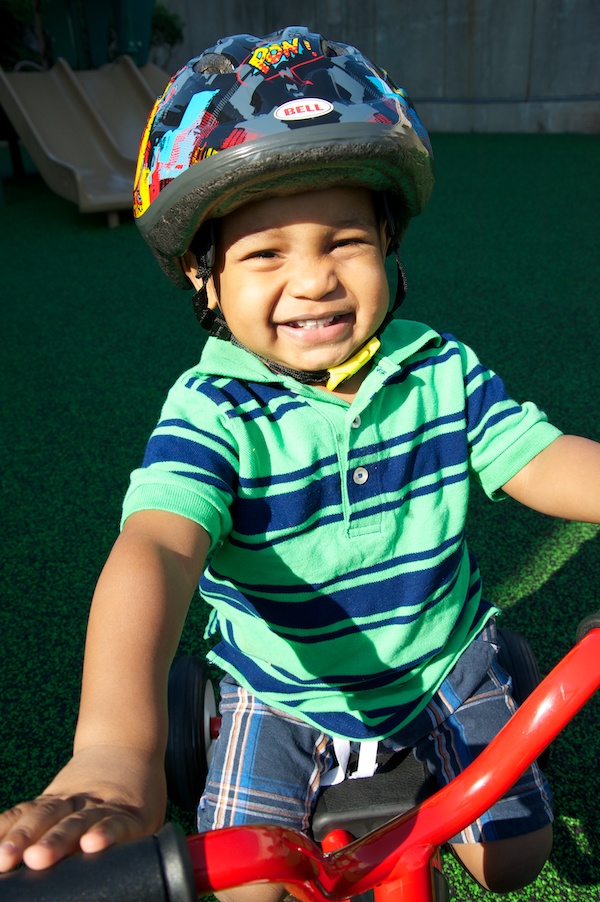 Oral injuries to the face and mouth happen often among young children. Because oral injuries can affect children for the rest of their lives, it is important for Head Start staff and parents to try to prevent these injuries.
Oral injuries to the face and mouth happen often among young children. Because oral injuries can affect children for the rest of their lives, it is important for Head Start staff and parents to try to prevent these injuries.
This Brush Up on Oral Health tip sheet discusses oral injuries that can happen to children. It also identifies strategies Head Start staff can use to help prevent these injuries.
Causes and Types of Oral Injuries
Most oral injuries happen when children fall. Children may stumble as they are learning to walk and when they are physically active. Injuries may happen when children trip on things, are pushed by another child, climb on stairs and furniture, or run with items in their mouths. Children’s top front teeth are injured most often. They can be chipped, pushed into the gum, pushed forward or back in the mouth, or knocked out. Bruises or cuts in or near the mouth are also common oral injuries. Some children receive burns from chewing on electrical cords that are plugged into a socket.
Impact of Oral Injuries
Preventing oral injuries is important for many reasons. Injured primary teeth can turn brown or black, cause pain, become infected, or have to be removed. Any one of these outcomes can affect the child’s self-esteem, ability to learn, and/or ability to eat healthy foods.
Early loss of primary teeth as a result of an oral injury or tooth decay can affect the condition of the child’s permanent teeth as well. Primary teeth keep space open for permanent teeth forming underneath. When primary teeth are lost too early, there may not be enough space for permanent teeth to grow.
Injuries to a child’s primary teeth can also damage the permanent teeth that are forming under the primary teeth. If a primary tooth is pushed into the gum, it can disturb the cells that are building the permanent tooth. This can cause discolored or deformed permanent teeth or permanent teeth that decay quickly. Injuries to primary and permanent teeth can affect a child’s speech, nutrition, self-confidence, and overall health.
Preventing Oral Injuries: What Head Start Staff Can Do

Head Start staff and parents can protect children from oral injuries by making the center and play areas safe. Here are some steps to take to help prevent oral injuries in Head Start programs:
- Do health and safety sweeps. Tour areas where children spend time. Use safety gates and cover sharp corners on furniture. Remove hazards or obstacles that could make a child fall. Make sure that toys and other things are picked up off the floor to help prevent children from tripping. Check that there is enough uncluttered space for children to move and play. Look over playground equipment to make sure it is age-appropriate.
- Set and enforce policies and procedures. Work with Head Start Health Services Advisory Committee members, parent committees, home visitors, child-safety experts, and others to identify behaviors that could cause oral injuries, and develop policies and procedures to help prevent oral injuries. Some examples include using child safety straps on high chairs, having children wear helmets when riding wheeled toys, and keeping toys picked up from the floor, playground, and yard. The policies and procedures should also address how to handle oral injuries (see Active Kids, Healthy Teeth: What to Do If…).
- Record, track, and analyze oral injuries. Head Start staff should document all injuries and inform parents if their child is injured. Keep a log of all injuries, and review the log quarterly to identify patterns about where and when injuries happen. This information can be used to determine what changes are needed to help prevent injuries.
- Educate staff, parents, and children. Use staff training and coaching opportunities, parent meetings, newsletters, and social media to teach Head Start staff, parents, and children how to avoid oral injuries. Invite oral health professionals, safety experts, and others to talk about how to prevent injuries.
Download a PDF version to print and share.
Read more:
Resource Type: Article
National Centers: Health, Behavioral Health, and Safety
Audience: Teachers and Caregivers
Series: Brush Up on Oral Health (BUOH)
Last Updated: April 26, 2023
